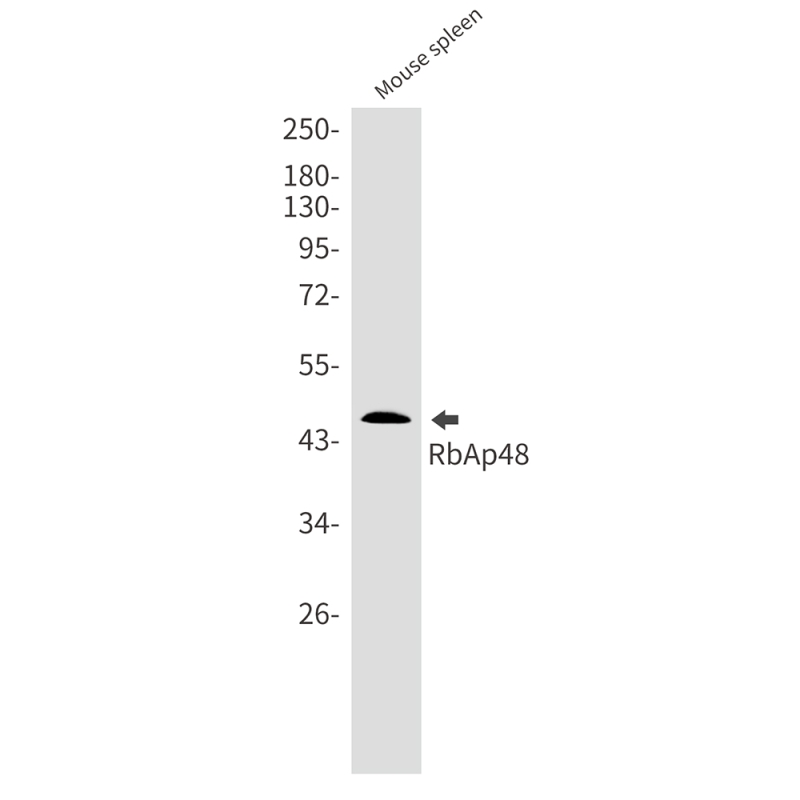
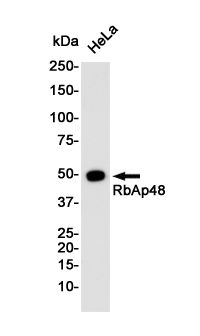
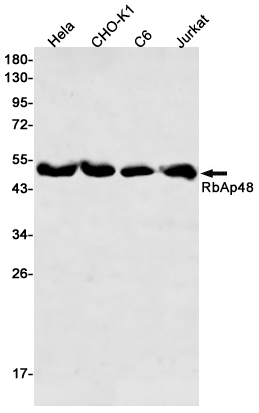
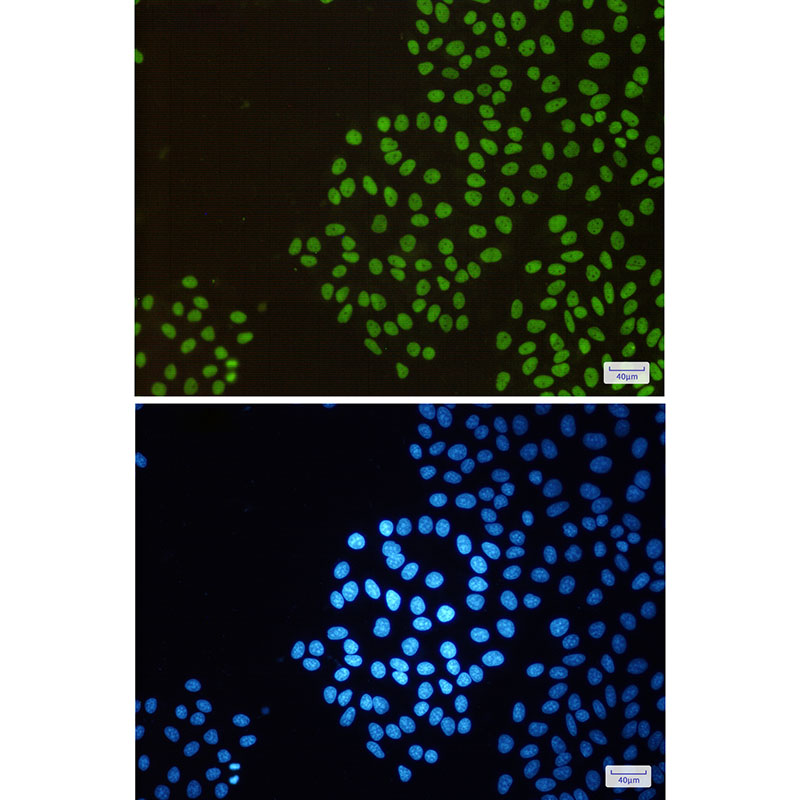
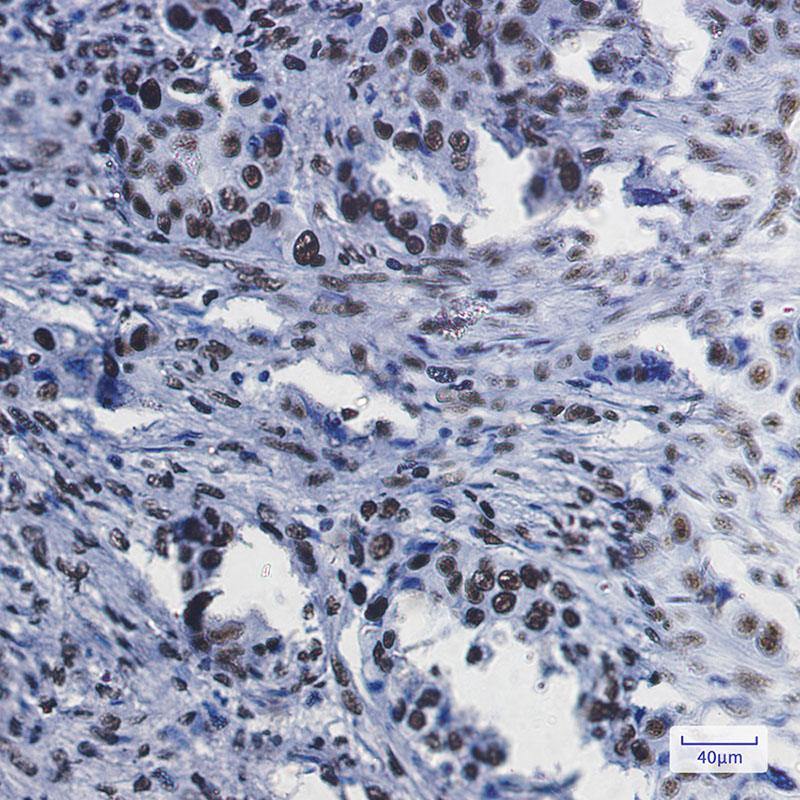
| WB | 1/500-1/1000 | Human,Mouse,Rat,Hamster |
| IF | 1/20 | Human,Mouse,Rat,Hamster |
| IHC | 1/50-1/100 | Human,Mouse,Rat,Hamster |
| ICC | 1/50-1/200 | Human,Mouse,Rat,Hamster |
| FCM | 咨询技术 | Human,Mouse,Rat,Hamster |
| Elisa | 咨询技术 | Human,Mouse,Rat,Hamster |
| Aliases | NURF55; RBAP48; lin-53 |
| Entrez GeneID | 5928 |
| WB Predicted band size | Calculated MW: 48 kDa; Observed MW: 48 kDa |
| Host/Isotype | Rabbit IgG |
| Antibody Type | Primary antibody |
| Storage | Store at 4°C short term. Aliquot and store at -20°C long term. Avoid freeze/thaw cycles. |
| Species Reactivity | Human,Mouse,Rat,Hamster |
| Immunogen | A synthetic peptide of human RbAp48 |
| Formulation | Purified antibody in TBS with 0.05% sodium azide,0.05%BSA and 50% glycerol. |
+ +
以下是关于RBBP4抗体的3篇参考文献的简要概括:
1. **文献名称**:*RBBP4 modulates histone deacetylation and MYC-driven tumor progression*
**作者**:Smith J, et al.
**摘要**:研究利用RBBP4抗体通过ChIP-seq和免疫沉淀技术,揭示了RBBP4在组蛋白去乙酰化复合体中的关键作用,并发现其通过调控MYC信号通路促进癌症进展。
2. **文献名称**:*Development and validation of a specific RBBP4 monoclonal antibody for epigenetic studies*
**作者**:Lee S, et al.
**摘要**:该文献描述了针对RBBP4蛋白的单克隆抗体的开发与验证,通过Western blot和免疫荧光实验证实抗体在检测内源性RBBP4表达及亚细胞定位中的高特异性。
3. **文献名称**:*RBBP4 interacts with p53 and regulates its function in DNA damage response*
**作者**:Wang Y, et al.
**摘要**:研究使用RBBP4抗体进行Co-IP和免疫组化实验,证明RBBP4与p53直接相互作用,并在DNA损伤修复中调控p53的稳定性及转录活性。
(注:以上文献信息为模拟示例,实际引用需查询具体数据库如PubMed或Google Scholar获取真实文献。)
RBBP4 (Retinoblastoma-Binding Protein 4), also known as RbAp48. is a conserved eukaryotic protein belonging to the WD40 repeat family. It plays critical roles in chromatin remodeling, histone modification, and transcriptional regulation by serving as a core component of multiple epigenetic complexes, including Polycomb repressive complex 2 (PRC2), NuRD (Nucleosome Remodeling and Deacetylase), and SIN3A/HDAC complexes. RBBP4 interacts directly with histones, particularly H3 and H4. functioning as a histone chaperone to stabilize nucleosome structure and mediate DNA replication or repair. Its involvement in gene silencing, cell cycle regulation, and differentiation has linked it to cancer progression, neurodegenerative diseases, and developmental disorders.
RBBP4 antibodies are essential tools for studying these biological processes. They are widely used in techniques like Western blotting, immunoprecipitation, chromatin immunoprecipitation (ChIP), and immunofluorescence to detect RBBP4 expression, localization, and protein interactions. Validated antibodies help characterize RBBP4's role in histone acetylation/deacetylation dynamics and its crosstalk with oncogenic or tumor-suppressive pathways. Commercial RBBP4 antibodies are typically raised against specific epitopes (e.g., human RBBP4 N-terminal or C-terminal regions) and are available as monoclonal or polyclonal formats. Researchers often validate them using knockout cell lines or siRNA-mediated knockdown to confirm specificity. Due to RBBP4's ubiquitous expression and conserved sequence, cross-reactivity studies across species (human, mouse, rat) are critical for experimental design.
×